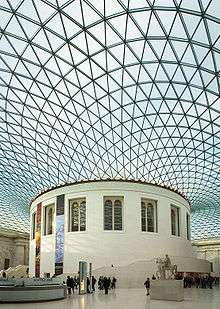Statue of Tara
|
The Statue of Tara on display in Room 33 at the British Museum | |
| Material | Gilded Bronze |
|---|---|
| Size | 143 cm high |
| Created | 8th century AD |
| Present location | British Museum, London |
| Identification | 1830,0612.4 |
Background
Buddhism has had a continuous history on the island of Sri Lanka ever since the third century BC. The figure dates to the period of Anuradhapura Kingdom founded in 377 BC by King Pandukabhaya. Buddhism played a strong role in the Anuradhapura period, influencing its culture, laws, and methods of governance. Tara shows evidence of the cultural interaction of Buddhism with Hinduism. Tara had been a Hindu mother goddess but was redesigned for a new role within Buddhism.[2] Sri Lanka is today a Theravada Buddhist country, like many other countries in South East Asia.[3]
At one time this statue was thought to be a model of the guardian deity Pattini, but it is now agreed that this statue is of Tara.[4] This identification is clear evidence for the presence in the medieval period of Mahayana Buddhism as well as the Theravada form of the faith which allows Buddhists to worship beings other than Buddha. The Abhayagiri vihāra of the Anuradhapura Kingdom being the most notable example. The statue suggests that Tara may have been worshiped as a deity and not just as the consort of a male god.[5]
Description
The sculpture represents a standing figure of a female deity solid cast in bronze using the lost wax process. The statue is about three quarter life size and it has been gilded to create the luxurious, golden appearance. The goddess's hour-glass upper body is naked with a lower garment tied to the hips with an almost ankle length hemline. Tara's right hand is shown in the gesture of giving while her left hand is thought to have held a lotus flower, now lost. The figure wears a high crown dominated by a medallion. The hole in the crown is supposed to have held a large precious stone.[4] The statue is the only known Anuradhapura example of this size that now survives. The statue would have been valuable not just from its appearance but also because of its manufacture. The statue was not hollow but made from an expensive metal using a technologically advanced technique of lost wax casting.[2]
Discovery
This rare sculpture was found in the early 1800s somewhere between Trincomalee and Batticaloa on the eastern coast of Sri Lanka. It was subsequently acquired by the then British Governor, Sir Robert Brownrigg, who later donated it to the British Museum.[1] This account however is rejected by the authorities in Sri Lanka who believe that Brownrigg took the statue from the last King of Kandy when the British annexed Kandy.[6] Kandy came under British rule in March 1815 under the terms of the Kandyan Convention which was organised by Brownrigg.[7]
When the British Museum acquired the statue, in the 1830s, they were concerned that the large exposed breasts, narrow waist and curvaceous hips would be seen as too erotic for the public so it was kept out of sight for thirty years.[2] The statue was only available for scholars to study even though it was never in doubt that the purpose of this statue had always been religious rather than to arouse. This scholarly study is strangely reminiscent of the statue's ancient status in Sri Lanka. It is thought that the statue would have only been seen in Sri Lanka by chosen priests and monks and it would not have been seen by the general population of Buddhists.[2] The British Museum had a number of items that from 1830 were considered too erotic. By the 1860s this store of objects was labelled the Secretum.[8]
Replica
There is a replica of this statue in the National Museum of Colombo in Sri Lanka.[5]
References
- 1 2 figure, Collection Online, British Museum, retrieved 9 December 2013
- 1 2 3 4 Episode 54 - Statue of Tara, BBC, retrieved 25 July 2014
- ↑ Buddhism in Sri Lanka, buddhanet.net, retrieved 9 December 2013
- 1 2 Statue of Tara, Highlights, British Museum, accessed 9 December 2013
- 1 2 The female as Cult Object in Buddhism, Digital Library, retrieved 10 December 2013
- ↑ Greenfield, Jeanette (1996). The return of cultural treasures (2nd ed.). Cambridge: Cambridge university press. p. 132. ISBN 0521477468.
- ↑ The signing of the Kandyan Convention, S. B. Karalliyadda, 25 February 2006, LankaLibrary, retrieved 9 December 2013
- ↑ Gaimster, David (2000). "Sex and Sensibility at the British Museum". History Today. Volume: 50 (9). Retrieved 25 July 2014.
Further reading
| Wikimedia Commons has media related to Statue of Tara, British Museum. |
- W. Zwalf (ed.), Buddhism: art and faith (London, The British Museum Press, 1985)
- R.E. Fisher, Buddhist art and architecture (London, Thames & Hudson, 1993)
- R. Thapar, The Penguin History of Early India from the Origins to AD 1300 (London, 2002)
- K.M. De Silva, A History of Sri Lanka (Berkeley, 1981)
- R. Coningham et al., "The State of Theocracy: Defining an Early Medieval Hinterland in Sri Lanka", Antiquity, 81 (2007), 699–719
| Preceded by 53: Lothair Crystal |
A History of the World in 100 Objects Object 54 |
Succeeded by 55: Chinese Tang tomb figures |

